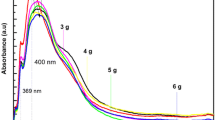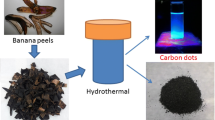Abstract
Carbon nanoparticles (C-dots) were prepared by refluxing the combustion soots of candles and corn stalk in nitric acid. The synthesized C-dots were characterized. The results showed a sharp increase in oxygen content and a sharp decrease in carbon content after oxidation. The C-dots had -OH and -CO2H groups introduced which made them hydrophilic. However, their difference was also obvious. The C-dots from candle soot had a 10-45 nm broad particle size distribution, and those from corn stalk soot had a 6-18 nm relatively small and narrow size distribution. The C-dots were mainly of sp 2 and sp 3 carbon structure different from the C-dots of diamond-like structure from candle soot. Interestingly, two kinds of C-dots all exhibited unique photoluminescent properties. The obtained C-dots have potential applications in a broad range of areas.
Similar content being viewed by others
References
Baker SN, Baker GA. Luminescent Carbon Nanodots: Emergent Nanolights[J]. Angew. Chem. Int. Edit., 2010, 49: 6726–6744
John CV. Luis AC. Fractionation of Carbon-based Nanomaterials by Anion-exchange[J]. Anal. Chem., 2012, 84(2): 1178–1183
Sun YP, Zhou B, Lin Y, et al. Quantum-sized Carbon Dots for Bright and Colorful Photoluminescence[J]. J. Am. Chem. Soc., 2006, 128(24): 756–7757
Liu HP, Ye T, Mao CD. Fluorescent Carbon Nanoparticles Derived from Candle Soot[J]. Angew. Chem. Int. Edit., 2007, 46: 6473–6457
Ray SC, Saha A, Jana NR, et al. Fluorescent Carbon Nanoparticles: Synthesis, Characterization, and Bioimaging Application[J]. J. Phys. Chem. C, 2009, 113(43): 18546–18551
Yang ST, Wang X, Wang H, et al. Carbon Dots as Nontoxic and Highperformance Fluorescence Imaging Agents[J]. J. Phys. Chem. C, 2009, 2113(43): 18110–18114
Yang ST, Cao L, Luo PG, et al. Carbon Dots for Optical Imaging in vivo[J]. J. Am. Chem. Soc., 2009, 131(32): 11308–11309
Cao L, Wang X, Meziani MJ, et al. Carbon Dots for Multiphoton Bioimaging[J]. J. Am. Chem. Soc., 2007, 129: 11318–11319
Liu R, Wu D, Liu S, et al. An Aqueous Route to Multicolor Photoluminescent Carbon Dots Using Silica Spheres as Carriers[J]. Angew. Chem. Int. Edit., 2009, 48: 4598–4601
Chen RJ, Bangsaruntip S, Drouvalakis KA, et al. Noncovalent Functionalization of Carbon Nanotubes for Highly Specific Biosensors[J]. Proc. Natl. Acad. Sci. the USA, 2003, 100: 4984–4989
Park KH, Chhowalla M, Iqbal Z, et al. Single-walled Carbon Nanotubes Are a New Class of Ion Channel Blockers[J]. J. Biol. Chem., 2003, 278: 50212–50216
Wang HB, Thoss M. Multilayer Formulation of the Multiconfiguration Time-dependent Hartree Theory[J]. J. Chem. Phys., 2003, 119: 1289–1299
Mitchell DT, Lee SB, Trofin LL, et al. Smart Nanotubes for Bioseparations and Biocatalysis[J]. J. Am. Chem. Soc., 2002, 124: 11864–11865
Guan B, Zou F, Zhi J. Nanodiamond as The pH-responsive Vehicle for An Anticancer drug[J]. Small, 2010, 6: 1514–1519
Chang YR, Lee HY, Chen K, et al. Mass Production and Dynamic Imaging of Fluorescent Nanodiamonds[J]. Nat. Nanotechnol., 2008, 3: 284–288
Sun YP, Zhou B, Lin Y, et al. Pyrolytic Formation and Photoluminescence Properties of A New Layered Carbonaceous Material with Graphite Oxide-mimicking Characteristics[J]. Carbon, 2009, 47: 519–526
Hu SL, Niu KY, Sun J, et al. One-step Synthesis of Fluorescent Carbon Nanoparticles by Laser Irradiation[J]. J. Mat. Chem., 2009, 19: 484–488
Neugart F, Zappe A, Jelezko F, et al. Dynamics of Diamond Nanoparticles in Solution and Cells[J]. Nano lett., 2007, 7: 3588–3591
Yu SJ, Kang MW, Chang HC, et al. Bright Fluorescent Nanodiamonds:? No Photobleaching and Low Cytotoxicity[J]. J. Am. Chem. Soc., 2005, 127: 17604–17605
Batalov A, Jacques V, Kaiser F, et al. Low Temperature Studies of the Excited-state Structure of Negatively Charged Nitrogen-vacancy Color Centers in Diamond[J]. Phys. Rev. Lett., 2009,102: 195506–195510
Zhao QL, Zhang ZL, Huang BH, et al. Facile Preparation of Low Cytotoxicity Fluorescent Carbon Nanocrystals by Electrooxidation of Graphite[J]. Chem. Commun., 2008,41: 5116–5118
Selvi BR, Jagadeesan D, Suma BS, et al. Intrinsically Fluorescent Carbon Nanospheres as A Nuclear Targeting Vector: Delivery of Membrane-impermeable Molecule to Modulate Gene Expression in Vivo[J]. Nano. Lett., 2008, 8: 3182–3188
Bourlinos AB, Stassinopoulos A, Anglos D, et al. Photoluminescent Carbogenic Dots[J]. Chem. Mater., 2008, 20: 4539–4541
Tian L, Ghosh D, Chen W, et al. Nanosized Carbon Particles from Natural Gas Soot[J]. Chem. Mater., 2009, 21: 2803–2809
Liu Y, Wu P. Graphene Quantum Dot Hybrids as Efficient Metal-free Electrocatalyst for the Oxygen Reduction Reaction[J]. ACS Appl. Mater. Interfaces, 2013, 5(8): 3362–3369
Sun D, Ban R, Zhang PH, et al. Hair Fiber as a Precursor for Synthesizing of Sulfur-and Nitrogen-co-doped Carbon Dots with Tunable Luminescence Properties[J]. Carbon, 2013, 64: 424–434
Yang YH, Cui JH, Zheng MT, et al. One Step Synthesis of Aminofunctionalized Fluorescent Carbon Nanoparticles by Hydrothermal Carbonization of Chitosan[J]. Chem. Commun., 2012, 48(3): 380–382
Li L, Wu G, Yang G, et al. Focusing on Luminescent Graphene Quantum Dots: Current Status and Future Perspectives[J]. Nanoscale, 2013, 5(10): 4015–4039
Xu J, Zhou Y, Liu S, et al. Low-cost Synthesis of Carbon Nanodots from Natural Products as Fluorescent Probe for the Detection of Ferrum (III) Ion in Lake Water[J]. Anal. Methods, 2014, 6(7): 2086–2090
Tang L, Ji R, Cao X, et al. Deep Ultraviolet Photoluminescence of Water-soluble Self-passivated Graphene Quantum Dots[J]. ACS Nano, 2012, 6(6): 5102–5110
Wu MB, Wang Y, Wu WT, et al. Preparation of Functionalized Watersoluble Photoluminescent Carbon Quantum Dots from Petroleum Coke[J]. Corbon, 2014, 78: 480–489
Rahy A, Zhou C, Zheng J, et al. Photoluminescent Carbon Nanoparticles Produced by Confined Combustion of Aromatic Compounds[J]. Carbon, 2012, 50(3): 1298–1302
Liang Q, Ma W, Shi YV, et al. Easy Synthesis of Highly Fluorescent Carbon Quantum Dots from Gelatin and Their Luminescent Properties and Applications[J]. Carbon, 2013, 60: 421–428
Liao B, Long P, He B, et al. Reversible Fluorescence Modulation of Spiropyran-functionalized Carbon Nanoparticles[J]. J. Mater. Chem. C, 2013, 1(23): 3716–3721
Author information
Authors and Affiliations
Corresponding author
Additional information
Funded by the National Natural Science Foundation of China (Nos. 21465019 and 21266023), the Ningxia Natural Science Founds (NZ13011), the Research Project for Science and Technology of Higher Education of Ningxia Provine of China (NGY2014011), the Science and Technology Planning Project of Jiangsu Entry-exit Inspection Quarantine Bureauof China (2016KJ50) and the Zhenjiang Social Development Project (SH2014021)
Rights and permissions
About this article
Cite this article
Li, Y., Chen, T. & Ma, Y. Nanosized carbon dots from organic matter and biomass. J. Wuhan Univ. Technol.-Mat. Sci. Edit. 31, 823–826 (2016). https://doi.org/10.1007/s11595-016-1452-2
Received:
Accepted:
Published:
Issue Date:
DOI: https://doi.org/10.1007/s11595-016-1452-2




